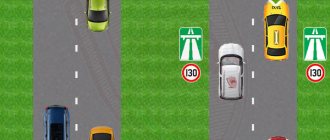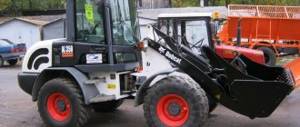What is the maximum speed limit for trucks?
It's no secret that incorrectly selected speed is the cause of most accidents on Russian roads.
That is why any motorist who cares about his vehicle and safety must know the maximum speed for his vehicle. Not many people know that following the speed limit not only reduces the likelihood of an accident, but also increases the service life of your car, because technical specialists took part in the process of identifying speed limits. There are several criteria for assessing the speed of a vehicle, but the main thing, of course, is the type of your transport. In this article we will look at the speed limit of trucks. The official dealer offers Scania trucks for sale scanezh.ru in Voronezh; vehicles can be purchased by paying for the purchase immediately, or by leasing on favorable terms.
Speed of a truck outside populated areas and on their territory
Freight transport is an indispensable assistant; it is used to transport cargo throughout the city and beyond. It is impossible to imagine how construction and international trade would be carried out without trucks. Trucks are used to transport almost any cargo, and the speed limit of a given particular truck depends on the type and weight of the cargo being transported.
The average technical speed of a truck is an important parameter that allows you to save time and money. It determines the speed while the car is in motion, taking into account all types of stops along the way. The average speed of freight transport is an important tool for logistics and truckers. The condition of the road and the car itself, the intensity of traffic on the route - everything affects the value of this parameter; it is determined by the ratio of the distance traveled by the car to the time of movement. A skillful driver chooses his route in such a way that this relationship has maximum significance.
Trucks can be classified according to different parameters, but if we take into account the speed of the vehicle, this transport is divided into:
- trucks that transport people;
— trucks of category B, the cargo weight of which does not exceed 3.5 tons;
— trucks with categories C and CE (carrying cargo weighing more than 3.5 tons).
How to calculate speed?
In fact, it can be calculated in several ways:
- through the formula for finding power;
- through differential calculus;
- by angular parameters and so on.
This article discusses the simplest method with the simplest formula - finding the value of this parameter through distance and time. By the way, these indicators are also present in the differential calculation formulas. The formula looks like this:
v=S/t, where
- v is the speed of the object,
- S is the distance that the object has traveled or must travel,
- t is the time during which the distance has been or should be covered.
As you can see, there is nothing complicated in the formula for the first grade of high school. By substituting the appropriate values instead of the letter designations, you can calculate the speed of movement of the object. For example, let’s find the speed of a car if it travels 100 km in 1 hour 30 minutes. First you need to convert 1 hour 30 minutes into hours, since in most cases the unit of measurement of the parameter in question is considered to be kilometers per hour (km/h). So, 1 hour 30 minutes is equal to 1.5 hours, because 30 minutes is half or 1/2 or 0.5 hours. Adding together 1 hour and 0.5 hours we get 1.5 hours.
Now you need to substitute the existing values instead of alphabetic characters:
v=100 km/1.5 h=66.66 km/h
Here v=66.66 km/h, and this value is very approximate (for those who don’t know, it’s better to read about this in specialized literature), S=100 km, t=1.5 hours.
In this simple way you can find speed through time and distance.
But what if you need to find the average value? In principle, the calculations shown above ultimately give the result of the average value of the parameter we are looking for. However, a more accurate value can be derived if it is known that in some areas the speed of the object was not constant compared to others. Then use this type of formula:
vav=(v1+v2+v3+…+vn)/n, where v1, v2, v3, vn are the values of the object’s velocities on individual sections of the path S, n is the number of these sections, vav is the average speed of the object along the entire path.
The same formula can be written differently, using the path and the time during which the object traveled this path:
- vav=(S1+S2+…+Sn)/t, where vav is the average speed of the object along the entire path,
- S1, S2, Sn - individual uneven sections of the entire path,
- t is the total time during which the object passed all sections.
You can also write to use this type of calculation:
- vср=S/(t1+t2+…+tn), where S is the total distance traveled,
- t1, t2, tn - time of passage of individual sections of distance S.
But you can write the same formula in a more precise version:
vср=S1/t1+S2/t2+…+Sn/tn, where S1/t1, S2/t2, Sn/tn are formulas for calculating the speed on each individual section of the entire path S.
Thus, it is very easy to find the desired parameter using the above formulas. They are very simple, and as already indicated, they are used in primary grades. More complex formulas are based on the same formulas and on the same principles of construction and calculation, but have a different, more complex form, more variables and different coefficients. This is necessary to obtain the most accurate indicator values.
Maximum speed of a truck for transporting passengers
Transporting people in the back of a truck is quite dangerous, so it must be equipped accordingly, namely, have a body with seats and a boarding ladder. The seats must be strong and well secured, and the boarding ladder must be secured to the rear side of the truck bed.
When transporting passengers in a truck, the driver must be especially careful when turning to avoid the possibility of injury to them. For the same reason, the speed limit for trucks of this kind is quite strict; the maximum speed can reach 60 km/h. The same rule applies when transporting children.
Mileage utilization rate (KUR)
Determines the degree of utilization of the vehicle's mileage with cargo.
When a car is operating on a line, mileages are distinguished:
general, loaded, idle and zero.
Total mileage
is the distance in kilometers traveled by a car during a working day.
A loaded run is a productive run.
Idle mileage
- this is the mileage of a vehicle without cargo between unloading and loading points.
Zero mileage
is the mileage of the vehicle from the depot to the loading point and from the last unloading point to the depot, as well as travel for refueling.
The mileage utilization coefficient is determined by the formula:
where:
Sгp — mileage with load, km; So.pr - total vehicle mileage, km.
Example.
The total mileage of the car per day was 320 km, with cargo - 244 km. Determine KIPR.
Solution.
The value of the mileage utilization factor depends on the location of loading and unloading points, the nature of cargo flows and the organization of dispatch service on the line. Innovative drivers are achieving reductions in unproductive miles driven by transporting associated cargo. For example, when transporting sugar beets from the field to the sugar factory, they use return flights to transport mineral fertilizers to the fields.
Speed limiter for trucks up to 3.5 tons
According to the international classification, trucks are usually divided into categories N1, N2 and N3. Vehicles weighing up to 3.5 tons fall into category N1 and are called light-duty trucks.
As a rule, trucks up to 3.5 tons are used to transport food products, industrial and household goods, construction materials and other goods that are small in volume and weight.
The speed of such transport depends on the type of road:
1. Motorway. On it, cars move at high speed, because it does not intersect with other roads. On this section of the road you must drive at a speed of at least 40 km/h. The maximum speed is affected by the location of the highway relative to the populated area. The maximum permitted speed of a truck is 60 km/h inside a populated area, while outside populated areas the speed on a highway can reach 110 km/h. There are very few highways in our country and it is better for trucks not to reach such speeds.
2. Road outside the city. For country roads, the maximum speed for trucks weighing up to 3.5 tons is 90 km/h.
3. In populated areas. Some cities do not allow trucks to enter certain streets, but such rules are rare. In the rest of the city, a truck can reach speeds of up to 60 km/h. However, in pedestrian areas or inside courtyards, the speed must be reduced to 20 km/h.
Average truck speed over 3.5 tons
Heavy trucks are huge steel machines, the kings of all roads. They are in great demand all over the world, transporting large quantities of cargo over long distances. Category C and CE trucks include all heavy goods vehicles, including tractor-trailers, that is, trucks.
The rules for driving such a vehicle on the highway are the same as for less heavy vehicles, with the only amendment that the maximum permitted speed of a truck over 3.5 tons on highways is 90 km/h. In populated areas, the speed of heavy trucks can also reach 60 km/h, while outside the city, according to traffic regulations, a heavy truck cannot exceed a speed of 70 km/h.
These are all the basic rules of the road for trucks, but if you see a speed limit sign on the road, then it is a priority and you must act in accordance with it. By carefully studying and applying in practice the speed limits for freight transport, you will not have to pay a fine for speeding, and your car will last longer.
Vehicle speed
The speed of cargo delivery is largely determined by the speed of the vehicle.
There is a distinction between average technical speed and operational speed. The average technical speed takes into account short-term stops along the way associated with traffic regulation and is determined by:
;
Where Tdv is the time of movement;
L - vehicle mileage.
The value of the average technical speed is influenced by:
— condition of the road surface;
— traffic intensity;
— dynamic properties of the car and its technical condition;
— features of the transported cargo;
— traffic conditions (time of day, weather conditions, time of year, frequency of stops along the way);
— qualifications and psychophysiological qualities of the driver.
Average technical speed standards: in the city, depending on the vehicle’s carrying capacity up to 7 tons - 23 km/h; 7 tons and above – 22 km/h.
When working outside the city: depending on the type of road surface
Average technical speed standards: in the city, depending on the vehicle’s carrying capacity up to 7 tons - 23 km/h; 7 tons and above – 22 km/h.
When working outside the city: depending on the type of road surface.
Table “Technical speeds of trucks when working outside the city”
Group of roads Surface type Technical speed, km/h
I improved (asphalt) 42
II transitional (gravel-crushed stone) 33
III lower (ground) 25
When working off-road, in quarries, when driving on virgin soil, the standard technical speed is reduced to 40%, when transporting goods that require special care - to 15%.
Standard technical speeds do not take into account whether a vehicle is moving loaded or unladen. The speed of an empty vehicle is on average 7-15% higher than that of a loaded vehicle. The results of field observations show that the technical speed in urban conditions depends little on the carrying capacity, but is determined by the intensity of the traffic flow from 29 to 39 km/h; outside the city on dirt roads (type 2) the technical speed can be up to 40 km/h, on intercity highways (type 1) the speed is up to 60 km/h.
Operating speed is calculated taking into account short-term stops along the way associated with traffic regulation, and vehicle downtime at loading and unloading points:
;
Where Vexp is the operating speed, km/h;
Lnar - total mileage of the car during the time in the outfit, km;
Tdv — total travel time during operation on the line, hour;
Тп-р - total downtime at loading and unloading points during the time on duty, hour.
Commercial speed (cargo delivery speed) - takes into account all available time costs, including the time the cargo lies in intermediate warehouses.
Distance between GO and GP
V com = —————————————————————— ;
t from the end of loading to the start of unloading
Truck speed
Good afternoon, dear reader.
This article will discuss the speed limits for trucks provided for by traffic regulations.
Today you will learn that in most cases the speed of trucks of categories C and CE is slightly less than the speed of cars in similar situations.
However, as practice shows, 99 percent of truck drivers switched to them from passenger cars, and they didn’t even bother to open the tenth section of the traffic rules before that. That's why trucks most often drive at a significant speed limit.
Today we will consider several groups of trucks:
First things first.
Speed of trucks categories C and CE
This group includes all heavy trucks, including tractors with semi-trailers (trucks). Their maximum speed is limited to the following values:
| Road | Speed Limit |
| On motorways | no more than 90 km/h |
| On country roads | no more than 70 km/h |
| In populated areas | no more than 60 km/h |
Almost every driver of a passenger car has encountered a situation when, on a suburban highway, while driving at a speed of 90 km/h, he was overtaken by a tractor with a semi-trailer (truck). At the same time, the driver of the truck exceeds the speed by 30-50 km/h, which can lead to quite a significant fine for speeding.
Let's consider another feature of the traffic rules that directly relates to the speed of trucks:
Note. By decision of the executive authorities of the constituent entities of the Russian Federation, an increase in speed may be allowed (with the installation of appropriate signs) on sections of roads or lanes for certain types of vehicles if road conditions ensure safe movement at a higher speed. In this case, the permitted speed should not exceed the values established for the corresponding types of vehicles on highways.
This article discusses the features of speed limits for different types of trucks on different sections of roads. I hope that after reading it, truck drivers will be more attentive to following traffic rules.
Source
Four misconceptions about speed
Dangerous stock
Everyone is used to driving with reserves. 60 is allowed, which means 80 is possible, since there is no fine for exceeding 20 km/h. But here’s the situation: there is no fine, but there is a violation. If suddenly an accident occurs, and an examination (measuring the length of the braking distance, etc.) or a traffic camera records that the speed of the car was higher than the permitted speed, not even by 20 km/h, but only by ten or five, then the driver will still be recognized guilty. And the punishment will depend on the severity of the consequences. If people get hurt, they will not only be fined, but also criminally punished - up to and including imprisonment.
Conclusion: if you are afraid of the consequences, do not add 20 to the speed limit.
The road workers caused chaos
Roads in the country, at least federal ones, have at least begun to be built and repaired. And they are repaired not by eye, but according to a design that has passed state examination. There are always a lot of unclear numbers in projects, including the “design speed” indicator. And it can be up to 150 km/h. Road workers will show journalists or bloggers their projects, and they will be happy to shout: it will be possible to drive 150 on the road, one word - autobahn! In fact, a new road opens, drivers see the “110” sign and begin to be rightfully indignant: where are the promised 150? But there are no such permits in our country. Design speed is a value for designers, not drivers. It means that a single car can safely drive at that speed on that road. That is, the road is wide enough and straight, without twisting or going up and down. But no one usually talks about this. So don’t look at these “design speeds”, anyway, at first it will not be more than 110, and after preparing the necessary documents, the owner of the road will be able to increase the maximum by another 20 km/h, as stated in the traffic rules.
But there is hope! More recently, the Chairman of the State Duma Committee on Transport and Construction, Evgeny Moskvichev, said that expressways are safer than ordinary roads, we need to forget the standards of the 70s of the last century and raise the bar for the maximum permitted speed up to 150 km/h. But only on new highways, where there are no zebra crossings, pedestrians and cyclists, traffic lights and intersections.
Conclusion: no more than 130 km/h is allowed yet.
Fast - expensive
After many years of competition among automakers for efficiency, they managed to teach us that a new passenger car does not consume fuel, but only sniffs it. Just five liters on the highway is not at all fantastic, even for a gasoline car. But this is subject to gentle handling of the gas pedal. If you press as hard as you can on it, the flow rate will easily increase two to three times. And if at a speed of about 90 km/h the needle lies somewhere just above two on the tachometer scale, then when accelerating to 140 - 150 it approaches four and the engine begins to roar and absorb fuel in buckets. This is the price to pay for pleasure, because gasoline is not cheap these days.
Conclusion: if you want to save money, focus on the tachometer, not the speedometer.
Maximum for a truck - 90 km/h
We are used to truckers flying along the roads, drivers swear on social networks: how long can you tolerate this! But the trick is that they are already prohibited from driving at the speed of cars. We read clause 10.3 of the traffic rules about the speed outside populated areas: “for other buses, passenger cars when towing a trailer, trucks with a permissible maximum weight of more than 3.5 tons on highways - no more than 90 km/h, on other roads - no more than 70 km /hour". That is, the difference between the maximum of a passenger car and the maximum of a heavy truck is 20 km/h.
It turns out that there is no point in scolding road workers here; if a truck or a large truck is trying to drive you off the road, like an enemy messenger, tailgating, then its driver is not just a boor, but also a violator, the traffic cop is crying for him. And over the years, truck drivers become more disciplined.
Conclusion: trucks are no match for your speed, the drivers just constantly break rules.
HELP "KP"
We persecute, but in moderation
How fast can a car travel?
In courtyards and residential areas - 20 km/h
In populated areas (road signs on a white background) - 60 km/h
Outside populated areas - 90 km/h
On motorways (road signs on a green background) - 110 km/h
On high-speed sections of highways - 130 km/h (only where there are signs “130”)
Where the limit signs are installed - at the indicated speed
Speed on long trips
The recommendation to drive without braking is especially relevant for those who enjoy long-distance driving. From those who often travel from Moscow to St. Petersburg, to Crimea, I often hear stories about driving on highways at speeds of 150 km/h and that in some areas you often have to overtake trucks. “How long did it take you to get from Moscow to St. Petersburg?” - I ask. “In 10 hours,” the reckless driver answers. This is where the dog is buried...
The concept of uniformity of motion
Look, from Moscow to St. Petersburg is about 700 km. If the driver drove without long stops for 10 hours, then his average speed was 700/10 = 70 km/h. It turns out that in empty sections he drove 150 km/h in order to arrive at an average speed of 70??? Was the game worth the candle? It is already clear to the naked eye that it was not worth it and that the speed was clearly too much. I'm not even talking about violating traffic rules, I'm just fighting for common sense. And if you look at the situation not just with the naked eye, but evaluate it scientifically, then there is a so-called coefficient of uniformity of movement:
K = Vcp/Vmax
where Vcp is the average speed along the way, and Vmax is the maximum speed that the driver maintained on the way.
The closer the coefficient is to unity, the more uniform and expedient the movement. That is, the closer the average speed is to the maximum, the more uniform the movement and the more appropriate the selected speed.
In our example with Moscow and St. Petersburg, the uniformity coefficient is 70/150 = 0.47. A very mediocre result, to put it bluntly. In free driving conditions, outside the city, the recommended values of the uniformity coefficient are above 0.7. It is clear that there is no such thing as exactly 1, but 0.9-0.95 on an open road without traffic lights is easy. In the city we can already talk about 0.4-0.5, but not on the St. Petersburg highway.
Evenness of movement is more important than speed
That is, in our example, the driver did not have to drive 150 to get there at an average speed of 70. It was advisable to reduce the speed. Many people think that reducing the maximum speed will lead to the same reduction in the average. For example, if you drive not 150, but 30 km/h slower - 120, then the average will end up not 70, but 40. This is a fallacy! In our example, the average will not change in any way, that’s the secret! If you try to drive evenly, in practice the average speed is only slightly lower than the maximum. In our case, the average speed will be 70 km/h, I think, if we try to keep it at 80 km/h the whole road. Do you feel the difference? Drive 150 or calmly hold 80 and arrive in the same time! In practice this will be the case. The trick is that you can’t keep 150 all the way. While you are driving to St. Petersburg, you encounter populated areas, traffic police posts, trucks, dangerous sections of the road - and all this forces you to slow down. And in the case of trucks, it happens that you end up in a “caravan” and have to overtake several dozen of them in turn, and drag for a long time behind each of them. It is in these places that we lose everything we have won, squeezing out 150 in each free area. Therefore, you should not waste unnecessary effort and fuel; you need to drive at the speed that will lead to uniform movement. Believe me, the average speed will not be affected in any way, but you will save a lot of fuel, effort and nerves, and add comfort and safety.
Evenly - when there is no braking
How to determine this optimal “uniform” speed? After all, you have to sit there, calculate the average, divide by the maximum, these coefficients... You'll be tortured! No, in practice everything is much simpler and is no longer new. You need to drive at the highest possible speed without braking. Then the movement will become uniform, and the speed will be close to average. That is, if you find yourself in a caravan of 20 trucks that go 80 km/h and which can only be overtaken in the “oncoming lane”, where cars are constantly driving towards you, you should not overtake them. You need to humble yourself and follow the truck. Or, as an option, you can make a previously planned stop (to refuel, rest, eat) and let the caravan go ahead, so that you can then drive along a freer road. If you lose, you will lose quite a bit in time, but you will gain, I repeat, in fuel consumption, strength, comfort, and safety. And again we come to the expediency of moving at the speed of the flow, only through other considerations











